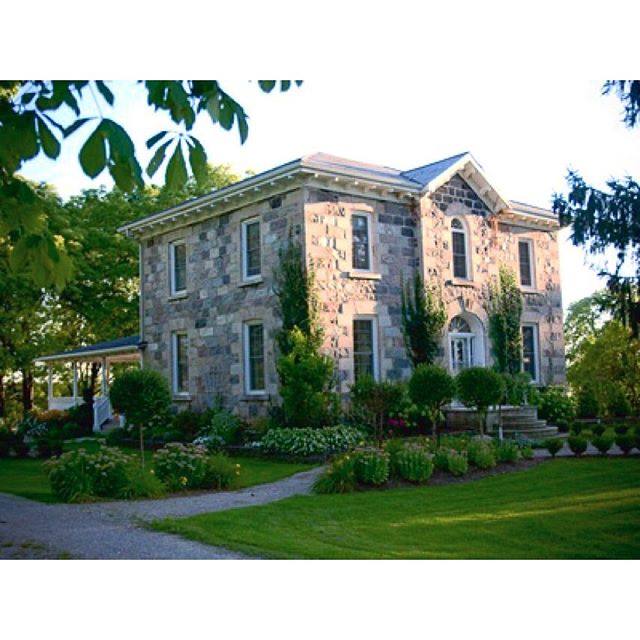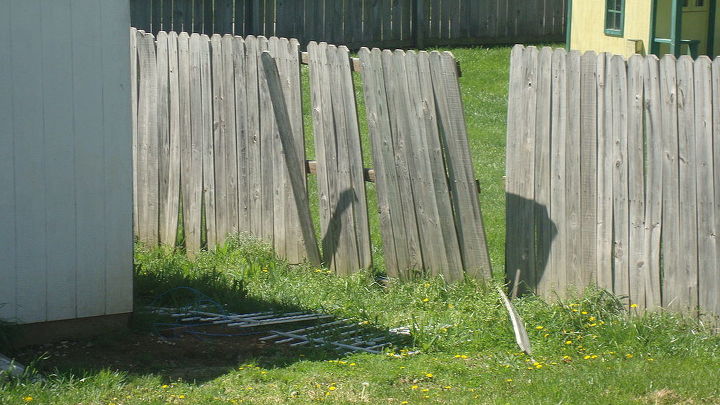Climbing vines on stone home

-
What a beautiful house. You have a large selection available. Here a just a few. Climbing Hydrangea. Honeysuckle. Trumpet Vine,Clematis etc.
 Janet Pizaro
on Feb 01, 2016
Helpful Reply
Janet Pizaro
on Feb 01, 2016
Helpful Reply -
-
What a lovely home! You already have a nice garden to work with. I'd definitely plant some clematis-maybe purple or maroon which would look wonderful against the stone. I'd also consider a climbing hydrangea on a part-shade side of the house. You can see an example in the post up on my blog.
 Three Dogs in a Garden
on Feb 01, 2016
Helpful Reply
Three Dogs in a Garden
on Feb 01, 2016
Helpful Reply -
-
To make sure not to grow any vines on your home (to avoid the damage) I would google espaliar gardening. In your zone the climbing hydrangea will grow slow. Be careful of any vines you plant because some are invasive like Trumpet vine and Japanese honeysuckle. I would look into some native vines and mix in with non native vines such as Clematis in assorted colors and times of blooms. Be careful with Sweet Autumn clematis because it can be invasive if it likes the area and will spread like wildfire (but the smell is heavenly in the late summer/early fall). I would create some sort of structure with wire to train the plants to grow on so they do not grow on the house. The repair bill to fix mortar on a house like yours would make a stone mason very happy. Good luck
 The Garden Frog with C Renee
on Feb 01, 2016
Helpful Reply
The Garden Frog with C Renee
on Feb 01, 2016
Helpful Reply -
-
We allowed vines to climb the side on our brick and wood two story home. Looked great but what a mistake. The vines held on the brick and wood with tiny feet. When it came time to repaint the eves, soffit, gutters and clean the brick we discovered the vine had damaged the mortar between the brick and was embedded in the wood. It was expensive to have the vines completely removed and necessary repairs made. We definitely do not recommend any type of vine be allowed to climb any material on our nor anyone's house. Good luck..
 Lou
on Feb 01, 2016
Helpful Reply
Lou
on Feb 01, 2016
Helpful Reply -
-
The important thing to look at as you consider climbers is the method they use to climb. Some vines put out small "feet" that dig into mortar and wood (English ivy is a good example of this)... these are very bad for homes. Other vines put out tendrils that curl around an grasp onto supports (grape for example). The third type is similar but the stems or leaves are what curl about the supports (clematis has curling leaves, morning glory has curling stems). Yet one last type will grow vertically, but they need the gardener to tie them up as they have no inbuilt climbing mechanism (climbing rose for one example). Both these last three (tendrils, twining, and tying) will not damage the surface of the house, but will need a trellis type support. And I hope you do go check out Three Dogs in a Garden's blog... it's wonderful!
 Kathleen Conery
on Feb 02, 2016
Helpful Reply
Kathleen Conery
on Feb 02, 2016
Helpful Reply -
-
Amongst the other suggestions, I would also add moonvine. So, one way to prevent damage to the facing of your house is to use some kind of metal lattice: concrete reinforcer, cattle panels and adhere them to the brick by extensions of say, 4" or so, so that there is a space between the wall and the panel/reinforcer. Then plant your vining plant... even roses, which are fairly in line with the history of your house, would do well... or make it edible with climbing grapes or cold hardy vining kiwi. You might consider also just planting some cypress or juniper for the green you are looking for without impinging upon the house. I did a search and came up with some of these: https://www.google.com/search?q=metal+lattice+to+keep+vines+off+house&espv=2&biw=1440&bih=835&source=lnms&tbm=isch&sa=X&ved=0ahUKEwjyo7-9qNnKAhWFLmMKHfZHC6MQ_AUIBygC
 Annie Medic
on Feb 02, 2016
Helpful Reply
Annie Medic
on Feb 02, 2016
Helpful Reply -
-
Boston Ivy is the safest ivy. It doesn't eat away to mortar between the bricks. Your home is an older one and no doubt the mortar is not the newer type that can withstand climbing plants. Clematis and moon vines are a good choice but you would need to use trellises or lattice work on your house for them to climb. Don't be surprised when you remove the existing vines you may need to do some repair work on the mortar.
 Elita Dare
on Feb 02, 2016
Helpful Reply
Elita Dare
on Feb 02, 2016
Helpful Reply -
-
I have a complete listing of types of vines on my Fosterginger at Pinterest . Start with your soil type , amount of sunlight during the day and plant zone . Use this info to help you chose your vines . I like clematis h. f. Young available now at Wal Mart . Hope that helps,
 G
on Feb 02, 2016
Helpful Reply
G
on Feb 02, 2016
Helpful Reply -
-
not only do you have to worry about the vines ruining your house, it also provides mice and other rodents nesting places as well a entrance into your beautiful hom I've seen mice climbing right up the walls
 Sheryl
on Feb 02, 2016
Helpful Reply
Sheryl
on Feb 02, 2016
Helpful Reply -
-
I have a 1872 Century Fieldstone Gothic Peaked farmhouse in Guelph similar to your townhome, and had the same advice. I ignored it however, and do not expect to have to repoint the stone in my lifetime - even though the last time it was done was a very inferior job. We have a lot of Wisteria (twiner needs strong support), Roses (no feet, so trellis must be provided), Boston Ivy (bright red in the fall), Virginia Creeper (even more beautiful in fall), Clematis (showy bred species will not reach the top of approx.25 foot walls in zone 5, but have no 'feet' to speak of and must be trained), Trumpet Vine (not a wall-hugger with little fingers that let go of stone) and of course morning glory, which twines without feet. The biggest issues are these: 1. Boston Ivy and Virginia Creeper will take off a few grains of pointing every time the excess is pulled down - and they can become rampant. If you look at some of the buildings at U of T, you will see that ivy can be pruned to have main trunk and branching structure - just like a rose on a trellis. We don't do this with our ivy, but it would mean you would be pulling off mostly less than year-old, tender growth which leaves young feet on the stone. If you have 10-12 ft ceilings, you'll need a very long ladder (ours is the classic story-and-a-half; our ladder is approx 27ft and springy in the middle. Fun.) 2. Providing screwed-in trellis for climbing roses can cause ice damage/cracking to the pointing; hopefully drilling into the stone (granite) will not. So far, so good (26 yrs.). 3. Damage WILL occur from footed vines, wisteria and trumpet ivy to wood and any modern materials you have. Footed vines will take off paint, trumpet ivy will grow through and rip off facia, etc., and wisteria will crush anything as small as a 4x4" (and must be pruned 1-2 times a year to bloom in our location, as flower buds are marginal in zone 6. South side planting required for blooms). 4. As you might surmise, the problem is not so much the need to repoint stonework (which is very expensive and requires skilled labour) as it is for growing season maintenance. 2-3x in a short growing season, my husband gets on our long ladder and prunes all vines away from all woodwork and cuts it even with the top of our upstairs windows to keep things from growin through the roof. This is "the minimal" work that must be done aside from training roses and clematis and pruning roses and wisteria for shape (and Boston Ivy, if you do like U of T does). It is NOT for non-active gardeners, and it makes 2 hr weekly grass cutting feel like childs play. But it is do-able; we are both in our 50's going on 60; he has MS and I am BiPolar without full use of my dominant hand. Choose this life-path carefully, adding on year-by-year, so you know fully what you are getting into. A cautious route would start with red Japanese Maple Trees and bright gold Rubekia for colour next to the stone - which looks fantastic - and add vines for texture and colour one-by-one.
 Duv310660
on Feb 05, 2016
Helpful Reply
Duv310660
on Feb 05, 2016
Helpful Reply- See 3 previous
-
-
Speak to your homeowner's insurance company about this. Many companies have underwriting guidelines, which state they can non-renew your policy if they find out you have any vegetation growing on your house.
 Michelle Harbee
on Feb 06, 2016
Helpful Reply
Michelle Harbee
on Feb 06, 2016
Helpful Reply -
-
So pretty and fabulous stone home that is covered from climbing vines.The architecture you have used in this home is really marvellous and I think how this vines would add privacy and give a natural touch to this home landscape. it’s true that vines are useful in the landscape as ground covers, as a covering for a fence or blank wall, or as shading on an arbour or trellis to cool a patio or deck. Thanks to those experts who have done this project.
 Elizabeth Sagarminaga
on Feb 09, 2016
Helpful Reply
Elizabeth Sagarminaga
on Feb 09, 2016
Helpful Reply -
Related Discussions
GNATS - How to get rid of them?
Somehow my house and garden got tiny gnats that killed my fuchsia plant and fly everywhere. I have tried ALL the Web recommendations - soap and oil dishes, sand in th... See more
Marigolds growing! Should I pinch the buds?
My marigold plants are growing. I heard that pinching the buds until Autumn will allow them to grow without killing the plant. Is this true?
Growing garlic
Growing our first garlic, should we wait until the leaves are drying out before we pick it? Husband picked first one today along with our first potatoes.
How to keep mice out of your garden?
Hi everyone, I have mice in my garden destroying my vegetables and I have also noticed them in the barn and shed. Please can someone tell me how to prevent them from ... See more
What's the best flower/plant to grow in Texas?
I know that opinions vary, but what's your opinion?!I have great luck w Rosemary plants. Green all year long.
Best way to kill bush/tree after being cut down?
Just moved into a new home. There was a huge thorny bush dragon devouring the mailbox. I slayed the dragon but it is trying to rise up again. How can I make sure it's... See more
Nightmare neighbors
We have the worst neighbors ever! They complain about everything! They hate dogs so they complain every time our dogs bark one time (not exaggerating) they have fabri... See more





